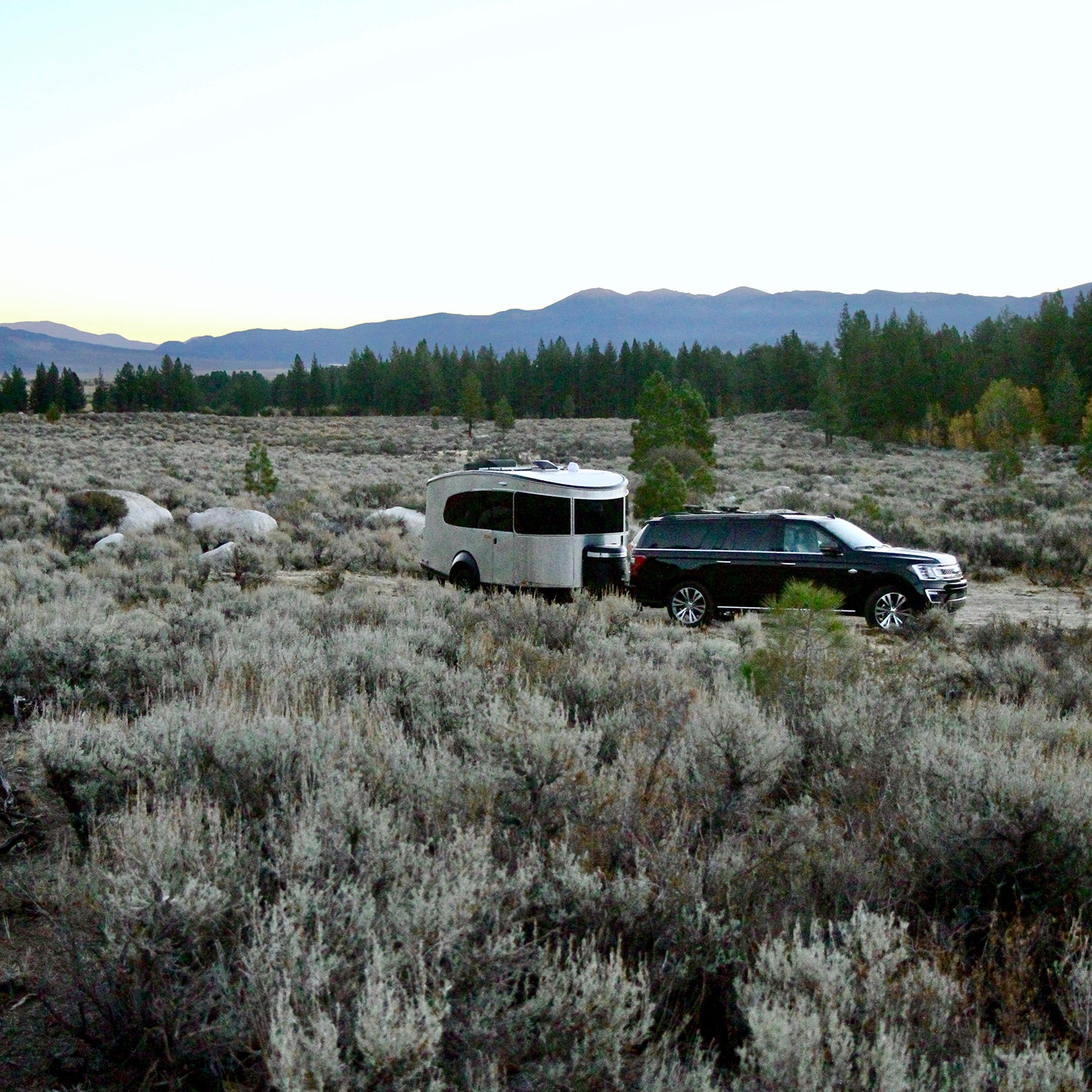After a six-hour drive, we╠řparked the loaner on a dirt road near Bridgeport, California, but we╠řknew╠řit╠řwasnÔÇÖt our final stop. Three friends and I╠řwere in the western corner of Humboldt-Toiyabe National Forest, a haven for dispersed camping, and I was determined to find an isolated patch of land somewhere up the unpaved road, with dreams of hiking trails╠řand hot springs outside our trailer door. It was Friday afternoon, though, and with the fall sun quickly disappearing below the sawtooth peaks of the eastern Sierra Nevada, the weekend crowds were drifting inÔÇöWinnebagos, Jeeps, and Jaycos, all snaking by, searching for their own spot away from everyone else.╠ř
After a few minutes of deliberation overlooking the alpine valley, a friend noticed a trail in the distance. ÔÇťHow about that?ÔÇŁ he suggested, pointing at a forest road pockmarked with small boulders and mountain sagebrush.╠řA narrow passage contoured╠řa pine-dotted hill, with a tiny turnaround visible about a half-mile ahead. The fifth wheels, toy haulers, and 30-footers could never navigate it, but our╠ř20-foot trailer might have a shot. Underneath the waning sun, we╠řrolled over rocks and squeezed between trees in our 2020 Ford Expedition Max╠ř4×4 until we╠řsuccessfully maneuvered the truck and the 3,500-pound trailer into a╠řdirt clearing, proving that the Basecamp X was far from╠řa burden╠řbut a gleaming wilderness pass to our own slice of serenity.╠ř
Living the nomadic lifestyle is a growing aspiration for many people, and camper vans are surging in popularity. Moments like the one we experienced in the Sierra╠řare exactly when you╠řwant to have╠řa vehicle like the Basecamp X. The trailer is well crafted and nimble both off-road and on, and IÔÇÖve found╠řthat it can be used for days away from water, gas, and electricity.╠ř
The Basecamp series contains╠řAirstreamÔÇÖs smallest models, and the 16-foot version has been the companyÔÇÖs top-selling trailer since it . The edict of the line is to be efficient, towable, and rugged. Or as Justin Humphreys, AirstreamÔÇÖs vice president of sales, put it, ÔÇťThe Basecamp model line was originally built for people looking to experience off-grid life and still have everything within reach.ÔÇŁ I tried the 16-foot model in February at╠řYosemite, but our adventure to the eastern Sierra╠řwas my first experience with . The X package, which I tested, adds $3,000 to the $45,900 base price and includes increased ground clearance, off-road Goodyear tires, and stainless-steel stone guards on the front end. ÔÇťThe Basecamp 20 encompasses all of the same off-grid capabilities as the 16╠řbut also represents a lot of market and customer feedback,ÔÇŁ Humphreys added. The╠řadditional bed and increased water-tank capacity were, to me,╠řthe most notable perks, and I much╠řpreferred this model to the 16-footer.
The interior of the 20-foot Basecamp X╠řis cleverly designed, with plenty of space for gear and food for the three other╠řintrepid campers╠řalong for╠řmy test. One example is the dinette table, which swivels to allow╠řwhoever is seated in the middle of the U-shaped booth to get out╠řwithout anyone else having to get up. In the smaller model, I had to pack away the bed each day to access╠řseating space, but not in the 20-footer, which accommodated cooking, storage, bathroom access, and a dining table in the front, even while the convertible king bed lay unfolded in the rear.╠ř
I quickly grew fond of stashing items in the open╠řoverhead compartments that are spread around the interior. These╠řcatch-all spaces are╠řmade of burly╠řmesh stitched to yellow cargo bars, providing transparent, unfussy storage, ideal for tossing random gear, snacks, and any extras like sunscreen or lanterns that╠řyou may want to grab quickly without bending over and rooting through a lower cabinet. (They╠řwouldnÔÇÖt be a good place to keep fragile items while in tow, however.)
The╠řhanging compartments, along with the underbed storage thatÔÇÖs accessible from the back hatch, are perfect representations of what this╠řtrailer does bestÔÇöit gives a sense of structure to the camping experience, but with a design that encourages you to spend more time outdoors than in. The Basecamp X╠řis simple to unpack inside, uncomplicated to run off-grid, and easy to tow. This is not the Airstream that affords╠řevery last comfort of home (for that, try the or the ), but it is the one that will get you on the trail quickest.╠ř
Beyond the cosmetics, Airstream made some intelligent designs in the guts of this trailer that help it thrive while boondocking. The two 12-volt Lifeline GPL-24T AGM Deep Cycle batteries╠řin the 2021 model, in conjunction with the 180-watt╠řrooftop solar package, are powerful and efficient. I couldnÔÇÖt drain them, despite using fans and lights liberally and running the fridge from the moment I picked up the trailer until I got home. There are also separate tanks for gray and black water, which turned out to be necessary, as I filled the gray tank more than halfway╠řafter four days of camp cooking. (The 16-footer has a combination tank, with about half the total capacity of the 20-footer.)
I never did find the limit of the Basecamp X while towing it behind the Ford Expedition.╠řIt was light enough to ascend and descend 6╠řpercent╠řgrades on asphalt without much push or pull, and rugged enough to bounce over sloping, rutted-out dirt paths and bumpy╠řback-road bridges en route to camp. Its╠řnarrow profile was helpful on forest roads, and shin-high rocks were no obstacle. I will say that, despite the additional three-inch lift and skid-plate protection in the X model, I kept a watchful eye on the underbody while off-road, concerned that one risky move might╠řcatch the exposed plumbing (though this never happened).╠ř
There are a few improvements I could envision. The stovetop, which otherwise works well, proved about two or three inches too small for my uses. While cooking for our group of four, I could fit one ten-inch cast-iron pan on it╠řbut not quite twoÔÇömeaning the pot or pan on the second burner would hang off the stove and rest on the metal countertop edging. It was doable╠řfor a weekend but not ideal, and it meant the second burner cooked things a little slower. There is also no way to tell when youÔÇÖre running low on propane (besides the olÔÇÖ backyard-BBQ shake-and-feel test), which can lead to your furnace shutting╠řoff in the middle of the night in 20-degree temperaturesÔÇöthat╠řhappened to us. Also, some form of trash receptacle would be welcomed, as we were often stumbling around our bag of trash and sticking it beneath╠řthe dinette table at night to avoid attracting animals.╠ř
Quibbles aside, the Basecamp X is poised to become a bestseller, thanks to╠řits relative affordability, modest footprint, and ability to get farther off the beaten path, and the 20-foot version is its ideal expression. After weeks largely stuck inside my house, or scouring my local forests for open trails away from smoke and crowds, the space I found in the trailer was life-giving. Still, itÔÇÖs a competitive time in the RV industry, and itÔÇÖs impossible to ignore the steep price tag. If you were playing with $50,000, would you opt to put it toward╠řa Mercedes Sprinter or a Dodge ProMaster? Maybe instead youÔÇÖd buy an old van, gut it, spend months of sweat equity building it back to your specs, and pocket the rest as savings for your adventures to come.╠řOr would you want this ready-made trailer, with classic looks, off-road chops, and a premium pedigree? There are pros and cons on each side and no perfect answer. But I do know that itÔÇÖs been a few days since IÔÇÖve returned╠řto sprawling, hazy Los Angeles, and IÔÇÖm still dreaming of nosing the trailer up a forested dirt road, parking between junipers and aspens, and swinging the back door wide open╠řfor a midday nap with an infinite view.╠ř


